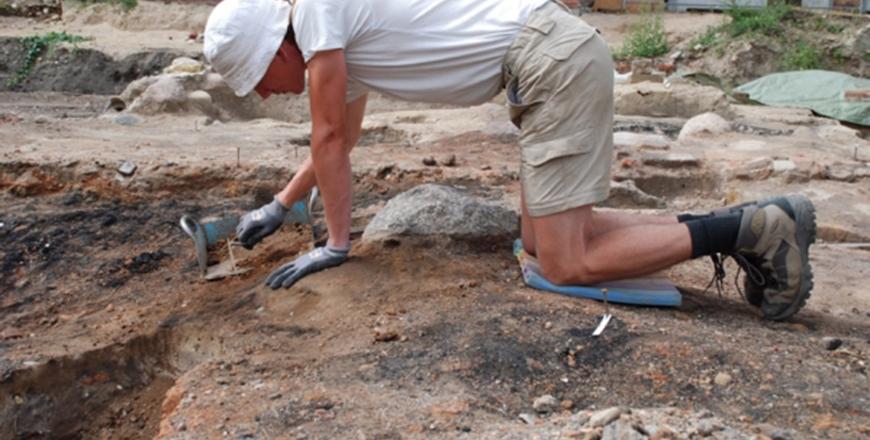You are here
Scientists unearth earliest-known stone tools, 3.3 million years old
By Los Angeles Times - May 24,2015 - Last updated at May 24,2015

Scientists discover the older stone tools made by humans dating back to 3.3 million years in Kenya (Photo courtesy of flickr.com)
Scientists working in Kenya have unearthed the oldest known stone tools, simple cutting and pounding implements crafted by ancient members of the human lineage 3.3 million years ago.
At about 700,000 years older than the other stone tools excavated to date, the discovery hints that anthropologists may have had the wrong idea about the evolution of humans and technology, said Stony Brook University archaeologist Jason Lewis, co-author of a study describing the find published Wednesday in the journal Nature.
Traditionally, Lewis said, scientists believed that stone tool-making emerged with the first members of our own large-brained genus, Homo, as they fanned out into savanna grassland environments about 2.5 million years ago.
Until now, the earliest-known stone tools dated back 2.6 million years, bolstering that hypothesis. But the discovery of tools crafted nearly three quarters of a million years earlier — during a period from which no Homo fossils have ever been found — suggests that the story might have played out differently, with human capabilities unfolding over a far longer period of time and with other branches of our family tree playing a more significant role than previously thought.
“We can’t associate this with creatures linked to our genus,” said Erella Hovers, an archaeologist at the Hebrew University of Jerusalem who was not involved in the study and who wrote an editorial accompanying the research, also in Nature. “Many thought Homo was the only toolmaker. Now that’s a position that’s hard to defend.”
Lewis and study lead author Sonia Harmand, also of Stony Brook University, on Long Island, lead the West Turkana Archaeological Project, an effort spanning two decades that explores northern Kenya’s Lake Turkana basin, a region famous for important fossil finds dating back 2.3 million years.
The newly discovered tools, which the scientists called “Lomekwian” after the Lomekwi 3 site where they were found, are different from so-called Oldowan tools from 2.6 million years ago, Harmand said.
Larger and heavier, they were manufactured using more rudimentary techniques. The team was able to figure out they were 3.3 million years old by studying the rock layers in which the tools were discovered, a standard approach for dating artefacts.
Hovers, who specialises in the study of early stone tools, said archaeologists had long suspected something more ancient than the Oldowan tools existed, because the 2.6 million-year-old artefacts appeared to have been crafted by expert toolmakers who knew what they were doing.
“Everyone had the feeling that these were not the first thing ever,” she said.
It’s unclear what creature made the Lomekwian tools. Lewis said the most likely possibilities were Kenyanthropus platyops (fossils of which have been found nearby) or Australopithecus afarensis (the species famously associated with the fossil known as “Lucy”.) An as-yet-unknown early member of the genus Homo also could have manufactured them.
“In any of these cases, it’d be a surprise,” Lewis said.
Paleoanthropologist William Kimbel, director of the Institute of Human Origins at Arizona State University in Tempe, called the discovery “gigantic” because it “breaks up the attractive link we’ve always made between large brains and stone tools”.
He said the vast, 700,000-year gap in time between the Lomekwian and Oldowan tools would present opportunities and challenges to scientists hoping to write the story of stone toolmaking.
“It will depend on finding more artefacts in the right time period,” said Kimbel, who was not involved in the study.
Hovers, who is also affiliated with the Arizona State institute, said that the Lomekwian discovery would help archaeologists know what to look for in future searches.
“For people in the field, this provides a good template,” she said. “I can imagine that many of us walked by stuff like this and didn’t realise what it was. Now you’ll bend down and pick it up.”
Harmand said that her team was preparing for its next field season and excavations at the site, starting at the end of June, and would be conducting further analysis on the tools.
They will continue the search beyond, too.
“We think there are older, even more rudimentary stone tools out there to be found,” she said.
Related Articles
A fragment of jawbone found in Ethiopia is the oldest known fossil from an evolutionary tree branch that eventually led to modern humans, scientist reported Wednesday.
RABAT — Archaeologists in Morocco have announced the discovery of North Africa’s oldest Stone Age hand-axe manufacturing site, dating back 1
WASHINGTON — Modern brains are younger than originally thought, possibly developing as recently as 1.5 million years ago, according to a rec
















